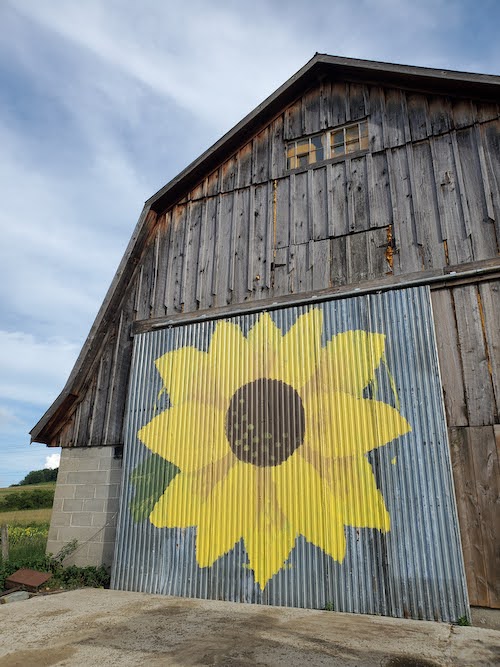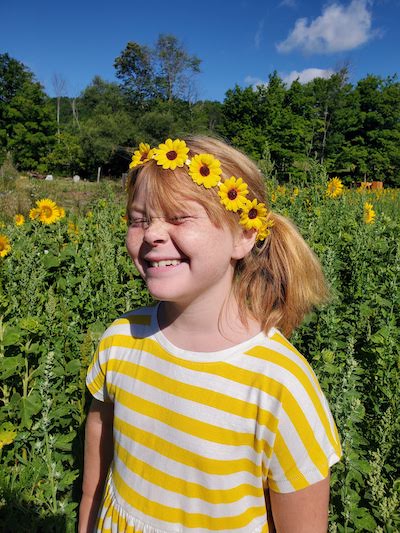Brianna Siegrist (briannasiegrist.com) has lived twelve years on the home farm, homeschooling and homesteading and learning to live with three generations. Photographs by the author.

We are clearing out the barn this week, my family and I. When I married into the family and saw the big weathered building full of “antiques” left behind by four generations, I had different ideas of what I’d find. I thought antiques were hand-hewn cedar chests containing a lock of hair and a ribbon-tied baklava of yellowed love notes. I pictured things that had been tenderly created and cared for, but forgotten. Instead, I inherited a hayloft full of chainsaw parts, broken lawnmowers, bent bicycles and business records. In clearing out, we are sorting: for the auction; the scrap; the burn pile. The burn pile is the largest.
We live in an unprecedented era of “things.” Before the Industrial Revolution, what we owned was likely created by human hands: clothes, furniture, tools, toys. Goods cost more money because they cost more in human time, and so when they required great skill, effort or length of time, they were more valuable and more carefully tended. Then came the factories. Machines allowed faster, less tedious “creation” of almost anything you needed – or wanted. Things got cheaper – in price and quality.
When my husband’s grandparents were married, they were gifted a few handmade pieces, but they largely filled their home with what was new, fashionable, affordable and available in the ’60s – pressboard furniture, plasticware. As they had been raised with depression-era sensibilities, these new mass-produced items were considered worthy of the same care and value as the high-quality items that had been in their childhood homes.
The time came for Grandma and Grandpa to disperse their estate, but their children had already filled their own homes. When we committed to caring for them, we didn’t realise it included their acquisitions. We dusted the things in the farmhouse; we are sorting the things in the barn. We’ve prayed for direction and wisdom: that we would know how to honour them and yet not be buried under piles of clutter.


I am an artist. I paint; I draw. While living on the family farm and raising my children, I’ve used my art to bless my family, community and church. I’ve often thought about Proverbs 22:29 – “Do you see a man who excels in his work? He will stand before kings; He will not stand before unknown men.” It seemed to me a promise – if I diligently apply myself to my craft, my work will eventually be valuable to others. It is – and it isn’t. On the one hand, I produce things I’m proud of, even that impress other people, but on the other hand, the over-supply of machine-produced art means that my hand-crafted items aren’t in high demand.
A few years ago, I produced a series of hand-lettered hymn lyrics over flowers. It felt meaningful to combine watercolour and calligraphy with purposeful words. I wanted to create art that would encourage people in their faith and bless them with courage and hope. The series sold dismally. In the gallery people admired and photographed them for social media, but they didn’t buy them. A few months later, I noticed that my local Dollar Store was selling similar prints at a twentieth of the price of my original art. I brought mine home in a cardboard box.
Ask any knitter whether her craft is financially lucrative. Or quilter. Or woodworker. Those who create art, music or poetry are often seen as hobbyists, even when highly competent. The world doesn’t need many pairs of lovingly stitched lace gloves. So, what is an artist to do? How do we continue to work at our craft in a world where it has so little value? I have often prayed for wisdom to find a way to provide for our family with my talent and skill.


Before we began the barn clean-out, we sold the cows. These 140 acres once housed about fifty milk cows, enough to provide a living for a family of seven. But milk prices have plateaued, and legislation favours mega-dairies of thousands of nameless cattle owned by a syndicate of men who have never had mud on their boots. Things are changing in the agricultural world. My husband’s Red Angus cattle, while beautiful and healthy and the product of much labour and care, were not producing enough for themselves or our family.
“What will we do with the land?” we asked each other. If the fields were left without grazing or mowing, they’d quickly go to shrub and thistle. My husband suggested putting in a corn maze to make a little money that first year without the cows.
It would have been easy to discourage him. How often had we worked at something on our little farm and had little to no community interest? But the Lord God is a God of hope – of new mercies every morning. And the Spirit inside us is encouraging, full of strategy and inspiration. An idea bubbled up inside me. ”What about a sunflower maze?” I asked. It would be unique. We looked out at the quiet green grass beside the barn, and I could almost see it full of happy yellow blooms nodding in the wind, the people browsing and being refreshed and revived. “Let’s do it,” he said, and we did.
With not much more than his rusty tractor and my acrylic paints, we made it happen. We ploughed and sowed the seed and prayed for rain. I painted signs with butterflies and bees for people to find. We mowed the winding paths and put up a tent at the entrance. When the flowers started blooming, people came. Children, families, friends. Some were neighbours; some drove from an hour away. In two weeks, more than two thousand people came out to wander in our countryside. They didn’t come to buy beef or paintings – but we had finally offered things that were vitally attractive – life, beauty and joy.


We are cleaning out the barn – the one with the giant sunflower mural. The auctioneer is on the schedule. The sunflowers in the field are turned toward the sky, just about to burst open for a second season of wondering at God’s creation. My paintings will live on in the backgrounds of people’s selfies. My husband and I walk hand in hand along the path and marvel at the enthusiastic turnout of our community.
The spirit of God in us inspires us to work with our hands – for the good of the earth and its people. Even if the economy has shifted, and people don’t want things as much, they still need love, encouragement and hope. In every generation and economic climate, we must lean on him to know what to put our hands to, whether cleaning out unneeded clutter or building something new and needed. And we also trust that while we work for him, he doesn’t only use us to bless others, but we are blessed ourselves.
The Kirby Laing Centre for Public Theology in Cambridge. Charity registered in England and Wales. Charity Number: 1191741
Kirby Laing Centre, The New Mill House, Unit 1, Chesterton Mill, French’s Road, Cambridge, CB4 3NP
© 2022 The Kirby Laing Centre for Public Theology in Cambridge